Sphinginae subfamily
Sphingini tribe:
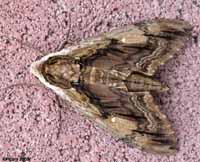 |
Ceratomia amyntor
USGS,
the Elm Sphinx or Four-horned Sphinx
This moth is officially recorded in Ramsey, but it
has been taken in all surrounding states nearby and in Berkshire County.
Larvae feed on Elm (Ulmus), birch (Betula), basswood (Tilia), and cherry (Prunus). |
 |
This moth is not officially recorded in Ramsey County.
It is named for the wavy lines on the forewings.
Note black and white collar separating thorax from abdomen. |
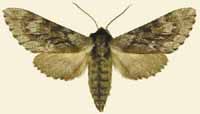 |
Reported from northern Minnesota and central western Wisconisn,
it might be present in Ramsey County. This is one we have on P.E.I.
|
 |
This species is not recorded in Ramsey County, but, if you
grow tomatoes, you have probably encountered it.
|
 |
Sphinx chersis
USGS, the Northern Ash Sphinx or Great Ash
SphinxThis species is recorded in Ramsey County.
Larval hosts are ash, lilac, privet, cherry, and quaking aspen.
|
 |
This species is not officially recorded, but it may be present. We have
them on P.E.I., but I do not see them frequently. unlikely |
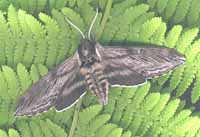 |
If you have blueberries in the woods, then you might have the Poecila Sphinx.
They are pretty common here on Prince Edward Island, but don't fly
too far west of Wisconsin. |
Smerinthini Tribe:
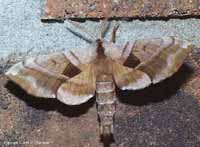 |
This moth is also fairly widely reported to the east and south
and might be present.
This is the first Sphinx species I reared as a boy in New Jersey.
See the file for the female; she is different. |
 |
This moth is found in Canada and states east, south and west of
Ramsey County, Minnesota,
so it is probably present in Minnesota too. |
 |
Named for the dull grey-blue spot in the hindwing, this moth has a
wide distribution and is possibly present in Ramsey County.
I regularly see them on Prince Edward Island. |
 |
Named for the small eye-spot in the hindwing, this moth has a wide distribution
and is probably present in Ramsey County.
I regularly see them on Prince Edward Island, and they are reported
as far south as Florida.
|
 |
Reported in northern Minnesota, it might be present in Ramsey County also.
At my home in Montague, P.E.I., Canada, they are quite common. |
 |
This moth is widely distributed to the east, so it may be present
in Ramsey County.
Along the East Coast, it flies from P.E.I. to Florida. |
Macroglossinae subfamily
Dilophonotini tribe:
 |
The abdomen has very distinct gray and black bands.
Adults nectar at dusk so you may see them in the garen at that time.
probably only as a stray
|
 |
Hemaris thysbe
WO, the Hummingbird Clearwing
This interesting day flier is not confirmed for Ramsey County.
They are widely distributed in the east from P.E.I. to Florida. |
See Hemaris comparisons.
 |
Hemaris diffinis
DM, the Snowberry Clearwing or Bumblebee Moth
This moth is widely distributed and is confirmed by Duane McDowell
for Ramsey County.
|
See Hemaris comparison,
August 16, 2005, Roseville, Duane McDowell.
Macroglossini tribe:
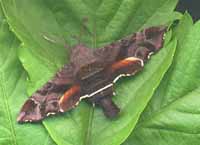 |
This day flier is widely distributed. If you have Virginia Creeper, you
might have the Nessus Sphinx. Two bright, distinct, narrow yellow
bands are often visible on the abdomen. generally more southerly
|
Amphion floridensis, nectaring at 5am, St. Paul, June 17,
2007, Neala J. Schleuning
Amphion floridensis
nectaring at lilacs, Arden Hills, June 14-19, 2008, Valerie Sweidan.
 |
Darapsa myron WO, the Virginia Creeper Sphinx or the Grapevine Sphinx
This moth is not recorded on the U.S.G.S. site for Ramsey County, but
is widely reported as far north as central Maine and west of Ramsey. If you have the
foodplants indicated in the common names, you probably have this
species nearby. |
 |
Hyles gallii WO, the Bedstraw Hawk Moth
or Gallium Sphinx
This species is not reported in Minnesota, but I expect it is present.
Some years I see them on P.E.I., some years, I do not.
|
 |
Hyles lineata
USGS/DM, the White-lined Sphinx
This species is recorded in Ramsey County.
It is a strong migrator from the south,
and there are records from the east and from the west. |
|
|

